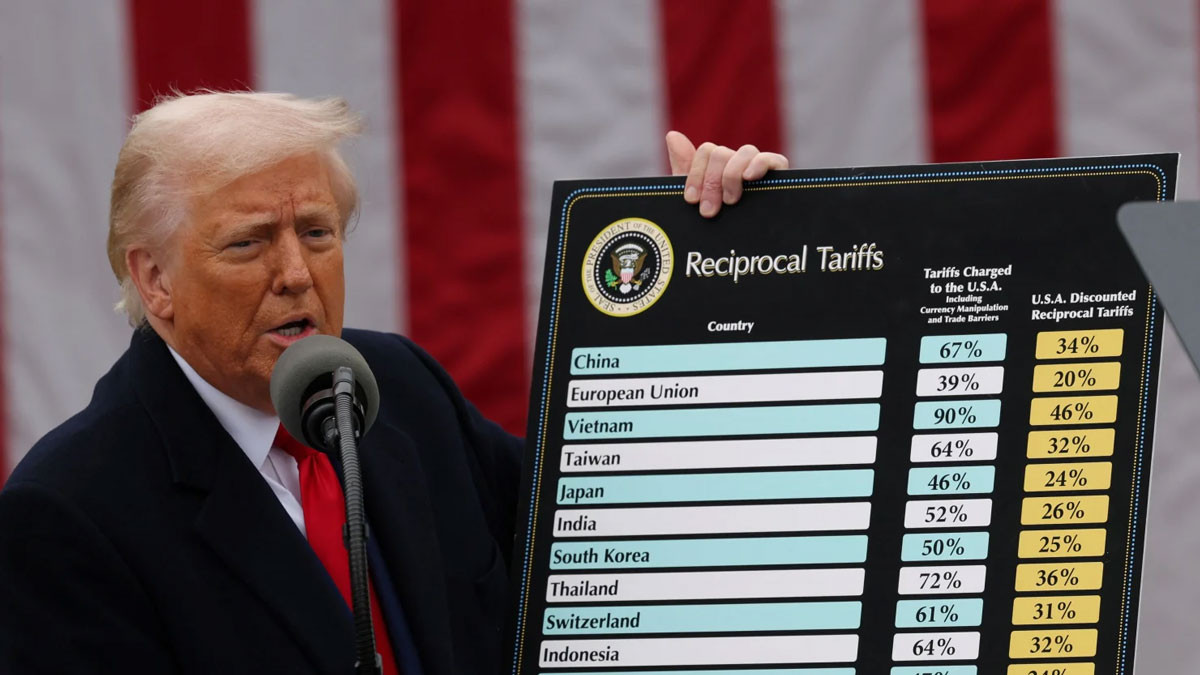Many other asset classes also fluctuated. The US dollar jumped, while oil prices also jumped. Will the court ruling change the world trade landscape, and what will happen to the market in the short and long term?
Tax blocking ruling, market fluctuates strongly
On May 28 in the US (early morning of May 29, Vietnam time), the Court of International Trade in Manhattan, New York, issued a historic ruling, declaring that the "Liberation Day" reciprocal tax decree of US President Donald Trump exceeded the authority granted by the Emergency Economic Powers Act (IEEPA) of 1977.
The three-judge panel stressed that the U.S. Constitution grants Congress exclusive power to regulate international trade and that emergency powers cannot be overridden by the president. The ruling, which originated in a lawsuit brought by the Liberty Justice Center on behalf of five small businesses that rely on imports, marks the first major legal challenge to Mr. Trump’s tariffs.
Previously, on April 2, Mr. Trump announced reciprocal tariffs on imported goods from more than 180 countries, with tax rates ranging from 10% to more than 40% for some partners such as Vietnam (46%) and China (a total of 145% after Beijing responded).
However, just a week later, he suspended tariffs for 90 days with more than 75 countries, keeping the basic tariff at 10%, to pave the way for negotiations.
On May 12, the US and China reached an interim trade agreement. The US reduced tariffs on Chinese goods from 145% to 30% within 90 days, while China reduced tariffs on US goods from 125% to 10%.
Mr. Trump’s tax policies have caused strong fluctuations in financial markets, with stock indexes having sessions of falling 4-5%. Gold prices once skyrocketed to a historical peak: 3,500 USD/ounce (on April 22). Meanwhile, the USD and oil prices have plummeted.
The US court's ruling on May 29 reversed the situation. The US stock market immediately reacted positively, with Dow Jones futures up 500 points (1.3%), S&P 500 up 1.5%, and Nasdaq 100 up 1.8% on the morning of May 29 (Vietnam time).
In contrast to stocks, the world gold price fell sharply from above the threshold of 3,300 USD/ounce to 3,250 USD/ounce at 8:30 am on May 29 in the Asian market. Early this morning, gold was also under pressure from the signal that the Federal Reserve (Fed) was not ready to cut interest rates. The minutes of the Fed meeting on May 6-7 showed concerns about prolonged inflation, especially from tariff policies, causing expectations of a rate cut in June to decrease sharply.
Domestically, the price of SJC gold bars dropped sharply to 117 million VND/tael.
The dollar rebounded, with the DXY index surpassing 100 after hitting a low of 99 last week. Oil prices also rose, with WTI crude rising to $62.70 a barrel (up more than 1.3%) on optimism about trade and concerns about supply if US-Iran talks fail.

Enforcement of judgments and prospects for financial and commodity markets
The ruling by the International Trade Court is a blow to Mr. Trump’s “America First” strategy, which relies on tariffs to narrow the $1.2 trillion trade deficit and boost domestic manufacturing.
However, enforcement of the ruling faces many challenges. The Trump administration has immediately appealed, and the process could be lengthy and could reach the Federal Circuit or the Supreme Court. During the appeal, the current tariffs, including a blanket 10% tariff and 25% tariff on cars, steel and aluminum, could remain in place, avoiding immediate disruption.
The Trump administration could also seek a stay of the ruling to maintain the status quo, especially as the White House argues that the trade deficit is a “national emergency” that threatens national security and the defense industry.
In fact, US federal courts also lack a direct mechanism to force executive compliance if the government delays or uses technical measures to circumvent the law.
The Trump administration could also deploy a variety of measures to maintain trade pressure. It could invoke “national security” to impose tariffs on strategic goods such as steel, aluminum, or automobiles, which are not affected by the May 28 ruling.
The White House could also prioritize bilateral negotiations, to reach agreements on selective tax reductions, avoiding violations of international trade laws.
In addition, the government can use the media to criticize the court, consolidate support from loyal voters, and increase subsidies to domestic farmers and businesses to offset the impact of trade instability.
The ruling could temporarily ease global trade tensions, especially with partners like China and the EU. If the tariffs are lifted, imports from these countries could rebound.
In the short term, US and global stock markets could continue to rally, buoyed by optimism following the court ruling and strong earnings reports from tech companies like Nvidia. The US dollar will continue to rally if the Fed keeps interest rates high, while gold prices could face further downward pressure due to reduced demand for safe havens. Oil prices will fluctuate, depending on the outcome of US-Iran talks and OPEC+ moves.
In the long term, if Mr Trump’s appeal fails, markets could stabilize, but policy uncertainty could make businesses hesitant to invest, slowing economic growth. Conversely, if the Trump administration tries to circumvent the ruling, the trade war could escalate, pushing up commodity prices and inflation. Gold prices could recover if geopolitical tensions rise.

Source: https://vietnamnet.vn/toa-an-tuyt-coi-thue-doi-ung-ong-trump-gia-vang-suy-yeu-2405926.html



































































































Comment (0)